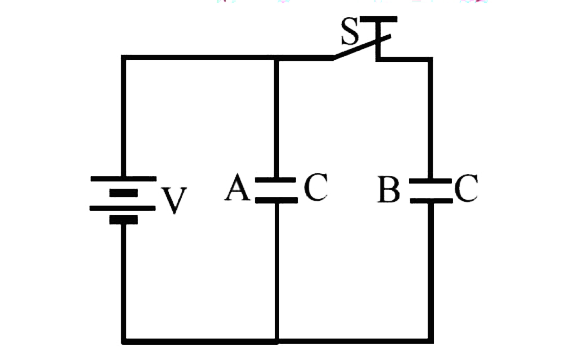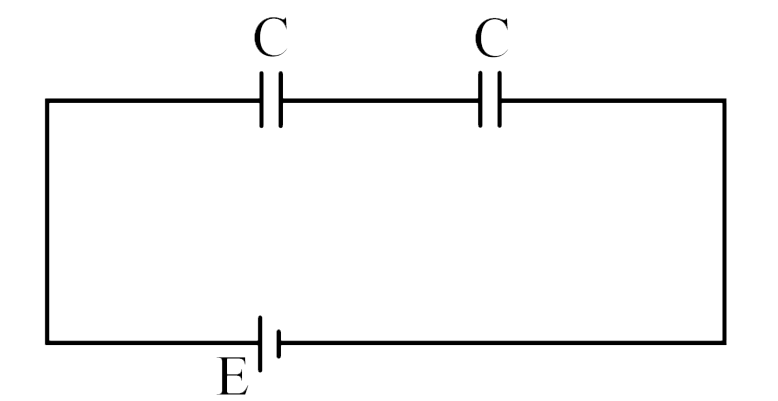Two parallel plate air capacitance C, were connected in series to a battery with emf ξ. Then one of the capacitors was filled up with uniform dielectric with permittivity ε. How many times did the electric field strength in that capacitor decrease ? What amount of charge flows throgh the battery ?
From the symmetry of the problem, the voltage across each capacitor, Δφ=ξ/2 and charge on each capacitor q=Cξ/2 in the absence of dielectric.
Now when the dielectric is filled up in one of the capacitor, the equivalent capacitance of the system,
C'0=Cε1+ε
and the potential difference across the capacitor, which is filled with dielectric,
Δφ'=q'εC=Cε(1+ε)ξCε=ξ(1+ε)
But φαE
So, as φ decreases 12(1+ε) times, the field strength also decreases by the same factor and flow of charge, Δq=q'−q
=Cε(1+ε)ξ−C2ξ=12Cξ(ε−1)(ε+1)
Topper's Solved these Questions
- BOOK - IE IRODOV, LA SENA & SS KROTOVCHAPTER - ELECTRODYNAMICSEXERCISE - Electric Current72videos
ELECTRODYNAMICS
- BOOK - IE IRODOV, LA SENA & SS KROTOVCHAPTER - ELECTRODYNAMICSEXERCISE - Constant Magnetic Fiels - Magnetics69videos
ELECTRODYNAMICS
- BOOK - IE IRODOV, LA SENA & SS KROTOVCHAPTER - ELECTRODYNAMICSEXERCISE - Conductors And Dielectrics In An Electric Field47videos
ELECTRODYNAMICS
- BOOK - IE IRODOV, LA SENA & SS KROTOVCHAPTER - ELECTRICITY AND MAGNETISMEXERCISE - All Questions6videos
ELECTRICITY AND MAGNETISM
- BOOK - IE IRODOV, LA SENA & SS KROTOVCHAPTER - ELECTROMAGNETISMEXERCISE - All Questions24videos
ELECTROMAGNETISM
Similar Questions
Two parallel plate capacitors of capacitance C each are connected in series with a battery of emf ε. Then, one of the capacitors is filled with a dielectric of dielectric constane K.
i. Find the change in electric field in the two capacitors, if any
ii. What amount of charge flows through the battery?
iii Find the change in the energy stored in the circuit, if any.View SolutionTwo parallel plate air capacitors, each of capacitance C=50 were connected is series ot emf ε=100V. Then one of the capacitors was filled with a uniforme dielectirc of relative permittivity ε=5 Compare the before and after the insertion of the dielectric? What amout of charge flows from the battery?
View Solution
Knowledge Check
- Question 1 - Select One
Two parallel plate air capacitance of same capacity C are connected in series to a battery of emf E. Then one of the capacitors is completely filled with dielectric material of constant K. The change in the effective capacity of the series combination is
AC2[K−1K+1]B2C[K−1K+1]CC2[K+1K−1]DC2[K−1K+1]2 - Question 2 - Select One
Two identical parallel plate air capacitors are connected in series to a battery of emf V. If one of the capacitor is completely filled with dielectric material of constant K, then potential difference of the other capacitor will become
AKV(K+1)BKVK+1CK−1KVDVK(K−1) - Question 3 - Select One
Two parallel plate air filled capacitors each of capacitance C, are joined in series to a battery of emf V. The space between the plates of one of the capacitors is then completely filled up with a uniform dielectric having dielectric constant K. The quantity of charge which flows through the battery is -
ACV2(K−1K+1)BCV2(K+1K−1)CCV(K−1K+1)DCV(K+1K−1)
Two parallel plate capacitors, each of capacitance 40 muF, are connected is series. The space between the plates of one capacitor is filled with a dielectric material of dielectric constant K =4. Find the equivalent capacitacne of the system.
View SolutionThe figure shows two identical parallel plate capacitors connected to a battery with the switch S closed. The switch is now opened and the free space between the plates of the capacitors is filled with a dielectric of dielectric constant(or relative permittivity) 3. Find the ratio of the total electrostatic energy stored in both capacitors before and after the introduction of the dielectric.
 View Solution
View SolutionTwo identical parallel plate capacitors of capacitance C each are connected in series with a battery of emf, E as shown. If one of the capacitors is now filled with a dielectric of dielectric constant k, the amount of charge which will flow through the battery is (neglect internal resistance of the battery)
 View Solution
View SolutionTwo capacitors of capacitance C are connected in series. If one of them is filled with dielectric substance K, what is the effective capacitance?
View SolutionTwo capacitors of capacitance C are connected in series. If one of them is filled with dielectric substance K, what is the effective capacitance?
View Solution

